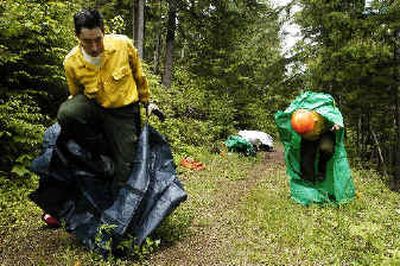Trainees get wildfire basics at camp

Jessica Christensen barely had a chance to celebrate her high school graduation last weekend.
Early Monday morning, while many of her former classmates were still snoozing, Christensen returned to the classroom. The 18-year-old from St. Maries, Idaho, is spending the week camping in a tent and attending Guard School – wildland firefighting’s equivalent of boot camp.
Christensen and about 75 other young men and women are learning everything from how to operate a pump to chopping firebreaks and safety procedures for riding in a helicopter. After taking an exam Friday and passing a physical fitness test, the students will be awarded the coveted red card, which grants them access to the fire lines and potentially fat firefighter paychecks.
Each has already been hired by a firefighting agency in North Idaho. Christensen will work for a U.S. Forest Service team stationed in Avery. Starting wage is $10.19 an hour.
“There aren’t any options to make this kind of money in town,” said Christensen, who plans to attend the University of Idaho in the fall.
The paychecks come at the expense of typical summer fun. During drought years, firefighters can expect to work 16-hour shifts for 16 days in a row. They will sleep in dusty, smoky fire camps. Their pay will be earned during endless hours of driving, hiking and digging. Some will earn more than $20,000.
Guard School attendance is down this year because fewer slots are open on North Idaho fire teams, said Lisa Spinelli, the school’s coordinator and a U.S. Forest Service employee from the St. Joe Ranger District. “The past couple of years have been extremely active so the money’s been good. There’s not much turnover.”
The week is designed to simulate life in a fire camp. The students sleep in one-person tents. The campground is about a half-mile walk from the classrooms at the Northern Lakes Fire Protection District headquarters along Hayden Lake. They wear fireproof clothing and leather boots. Alcohol and drugs are strictly forbidden – as they are in every fire camp. Lights go out at 10 p.m.
The first two days of Guard School are mostly spent in a classroom. The students listen to lectures on fire behavior and the basics of fire suppression. They learn the difference between bambi buckets and bladder bags (one’s hauled by a helicopter, the other on the back of a firefighter). The instructors teach from a strict set of guidelines, but they sprinkle in their own experiences. Instructor Renee Kuehner discussed the importance of steering clear of fire retardant drop zones. The planes are awesome sights, she said, but the retardant weighs 10 pounds a gallon. A direct hit could be crushing.
“It really is impressive,” Kuehner told the class. “You’ve got this huge plane just thundering at you. You can get some really cool pictures … But definitely get out of there.”
Many of the students attend college during cooler months and use their fire pay for tuition. Richard Bailey just wants a break from his job at a Sandpoint grocery store. He was recently hired by the Idaho Department of Lands.
“I want an outside job,” the 19-year-old said during a break between classes Tuesday. “I’m sick of being cooped up.”
Standing in a circle near Bailey was a group of students playing Hacky Sack while wearing clunky fire boots. A light rain fell. The surrounding forest was full of spring’s new growth. With the ground sopping wet, prospects were looking grim for a hands-on firefighting exercise Thursday.
During the exercise, bonfires deep in the forest are lit. Students must use map and compass skills to locate the blaze, then chop a fire line with hand tools. Everything is done under the watchful eye of instructors.
Although few summer jobs pay as well, many of the students say money is not the main reason they signed up to be a firefighter.
“I’m majorly into the excitement of the fires and all the travel,” said 19-year-old St. Maries resident Cammie Collins.
Thanks to better technology and training, wildland firefighting has become safer and more effective, said Craig Ely, a fire safety officer and the road manager for the Coeur d’Alene River District of the Forest Service. But Ely said no training will be able to top the lessons that will come later in the summer, when lightning and careless campers begin torching the region’s forests.
“There’s no substitution for the real deal,” said Ely, who has been fighting forest fires since the late 1970s. “Until you actually eat some smoke and dig some fire lines, it doesn’t click.”